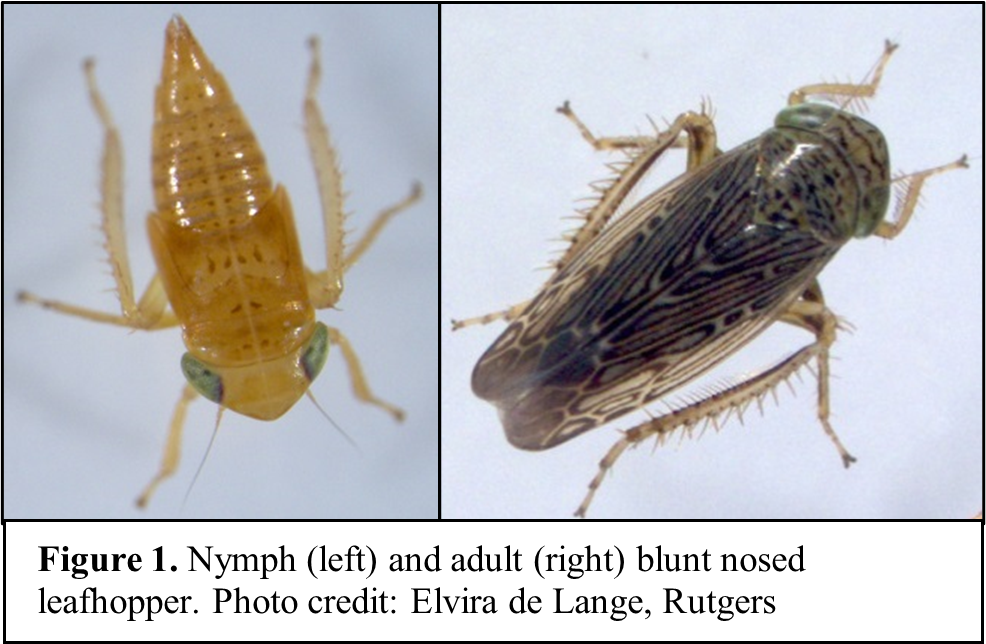Watching For Leafhoppers This Spring and Summer
Leafhoppers are common insects throughout the landscape and several species may be found in cranberry, including the blunt nosed leafhopper (BLNH, figure 1), the sharp-nosed leafhopper, the cranberry vinehopper (Averill and Sylvia, 1998), and potato leafhoppers that may blow in with the wind from southern states. The primary concern with many species of leafhoppers, and particularly the BNLH in cranberry, is their ability to vector disease through feeding on sap from the phloem, usually on the underside of leaves.

As we discussed at the miniclinic, the BNLH is native to the Eastern US, including Wisconsin, feeds on Ericaceae, and is the only known vector to date of the phytoplasma responsible for the false blossom disease (FBD). Patty McManus discussed FBD in a previous issue of CCMJ (1) and in this publication (2). If you are interested in learning more about BNLH, see this publication from Rutgers University (3).
In general, leafhoppers (except for BNLH) do not warrant the use of an insecticide as their feeding does not, by itself, usually result in economic damage. According to the University of Maine, very high numbers of 100 to 200 leafhoppers per 25 sweeps have been reported to drain the water and sugar out of cranberry vines significantly (https://extension.umaine.edu/cranberries/grower-services/insects/blunt-nosed-leafhopper/).
When it comes to BNLH, the tentative thresholds established in New Jersey are 20 BNLH nymphs per sweep set in young beds, new varieties, and/or with FBD incidence or 40 BNLH nymphs per sweep set in older beds, older varieties, and no FBD incidence.
It is thus really important to monitor for the immature nymphs at prebloom and identify the nymphs to species to determine which threshold to use before implementing chemical controls. When it comes to identifying the nymphs, PJ Liesch at the UW-Madison Insect Diagnostic Lab, private scouts and Ocean Spray can help with identification.
It is recommended to monitor starting around mid-May using sweep nets. If you detect leafhoppers and reach one of the different thresholds discussed above for BNLH or other species, you should apply an insecticide at pre-bloom. The most efficacious insecticides for leafhoppers nymphs are the broad spectrum organophosphates (e.g., Lorsban, Orthene, Imidan, Diazinon), carbamates (e.g., Sevin), or pyrethroids (e.g., Danitol, though Danitol is not allowed this year by some handlers). Neonicotinoids are also efficacious against leafhopper nymphs but are not recommended prebloom as the active ingredients accumulate in nectar and pollen and can affect bees foraging on flowers. For organic growers, while we did not assess organically-approved insecticides against leafhoppers, Pyganic is likely to be the most efficacious pre-bloom.
After bloom in mid-July or so, you may start seeing adults in beds. For BNLH, there is only one generation per year. Eggs are laid in July-August and these eggs will be overwintering, so while targeting the adults is not the best option and insecticides tend not be as efficacious on adults, it may still be warranted to spray an insecticide if numbers are high. At that time, organophosphates, pyrethroids, and neonicotinoids (e.g., Venom) will provide some control and Pyganic for organic growers remains an option.
Happy growing season!
References:
- https://njaes.rutgers.edu/fs1248/
- https://wood.extension.wisc.edu/files/2019/05/Issue-5.pdf
- https://cdn.shopify.com/s/files/1/0145/8808/4272/files/A4169.pdf

